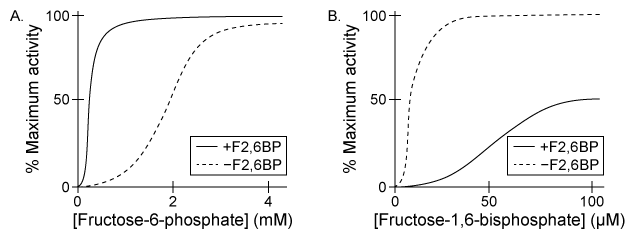Passage Glycolysis and Gluconeogenesis Are Tightly Regulated, Opposing Metabolic Pathways That
Passage
Glycolysis and gluconeogenesis are tightly regulated, opposing metabolic pathways that help control blood glucose levels. Glycolysis converts glucose to two pyruvate molecules, whereas gluconeogenesis consumes 6 ATP equivalents to convert two pyruvate molecules back to glucose. When glycolysis is upregulated, gluconeogenesis is downregulated, and vice versa.As shown in Figure 1, glycolysis and gluconeogenesis in the liver are largely regulated by the allosteric action of the small molecule fructose-2,6-bisphosphate (F2,6BP) on the enzymes phosphofructokinase-1 (PFK-1) and fructose-1,6-bisphosphatase (F1,6BPase) . PFK-1 is a kinase that uses ATP to phosphorylate fructose-6-phosphate (F6P) in an irreversible step of glycolysis, forming fructose-1,6-bisphosphate (F1,6BP) and ADP. During gluconeogenesis, F1,6BPase removes the phosphate group by hydrolysis.
 Figure 1 Activities of (A) PFK-1 and (B) F1,6BPase in the presence (solid lines) and absence (dashed lines) of F2,6BPA bifunctional enzyme that contains a phosphofructokinase-2 (PFK-2) domain and a fructose-2,6-bisphosphatase (F2,6BPase) domain controls F2,6BP levels in the liver. The PFK-2 domain converts F6P to F2,6BP, and the F2,6BPase domain converts F2,6BP back to F6P. When blood glucose levels are low, the enzyme becomes phosphorylated. This phosphorylation event simultaneously activates the F2,6BPase domain and inactivates the PFK-2 domain. Under high blood glucose conditions, the enzyme becomes dephosphorylated, activating the PFK-2 domain and inactivating the F2,6BPase domain.
Figure 1 Activities of (A) PFK-1 and (B) F1,6BPase in the presence (solid lines) and absence (dashed lines) of F2,6BPA bifunctional enzyme that contains a phosphofructokinase-2 (PFK-2) domain and a fructose-2,6-bisphosphatase (F2,6BPase) domain controls F2,6BP levels in the liver. The PFK-2 domain converts F6P to F2,6BP, and the F2,6BPase domain converts F2,6BP back to F6P. When blood glucose levels are low, the enzyme becomes phosphorylated. This phosphorylation event simultaneously activates the F2,6BPase domain and inactivates the PFK-2 domain. Under high blood glucose conditions, the enzyme becomes dephosphorylated, activating the PFK-2 domain and inactivating the F2,6BPase domain.
-All of the following statements about PFK-1 and F1,6BP are correct EXCEPT:
A) PFK-1 cooperatively converts F6P to F1,6BP.
B) F1,6BPase cooperatively converts F1,6BP to F6P.
C) Both PFK-1 and F1,6BPase have multiple active sites for catalysis.
D) F1,6BPase catalyzes the reverse reaction of PFK-1 to regenerate ATP.
Correct Answer:
Verified
Q294: Passage
Glycolysis and gluconeogenesis are tightly regulated, opposing
Q295: Passage
Destabilase, an enzyme found in the saliva
Q296: Passage
Glycolysis and gluconeogenesis are tightly regulated, opposing
Q297: Certain RNA molecules can fold into structures
Q298: An enzyme generates a Lineweaver-Burk plot with
Q300: Passage
Destabilase, an enzyme found in the saliva
Q301: Passage
The HIV-derived transactivator of transcription (Tat) is
Q302: Passage
The HIV-derived transactivator of transcription (Tat) is
Q303: The electron transport chain results in the
Q304: Passage
The HIV-derived transactivator of transcription (Tat) is
Unlock this Answer For Free Now!
View this answer and more for free by performing one of the following actions

Scan the QR code to install the App and get 2 free unlocks

Unlock quizzes for free by uploading documents